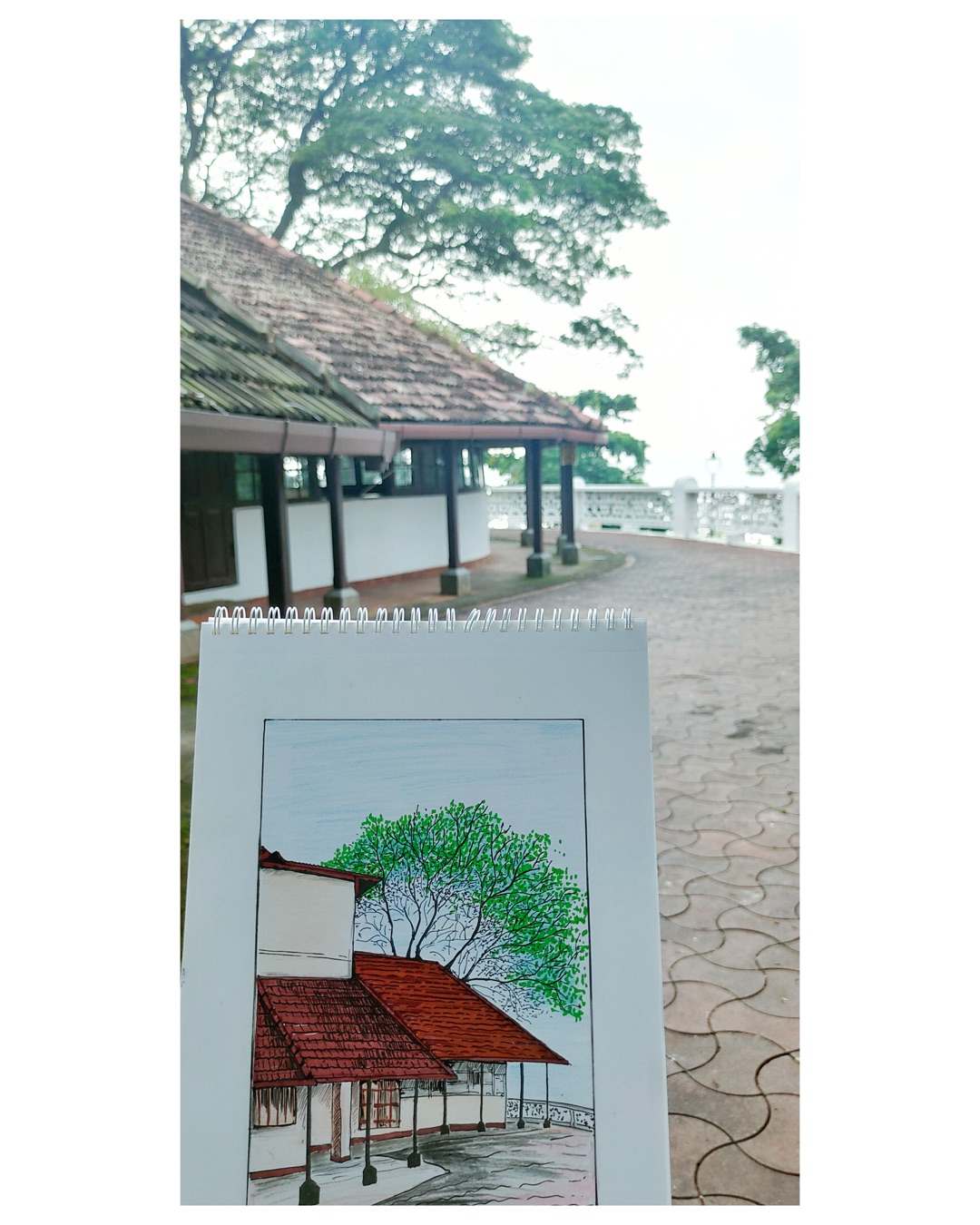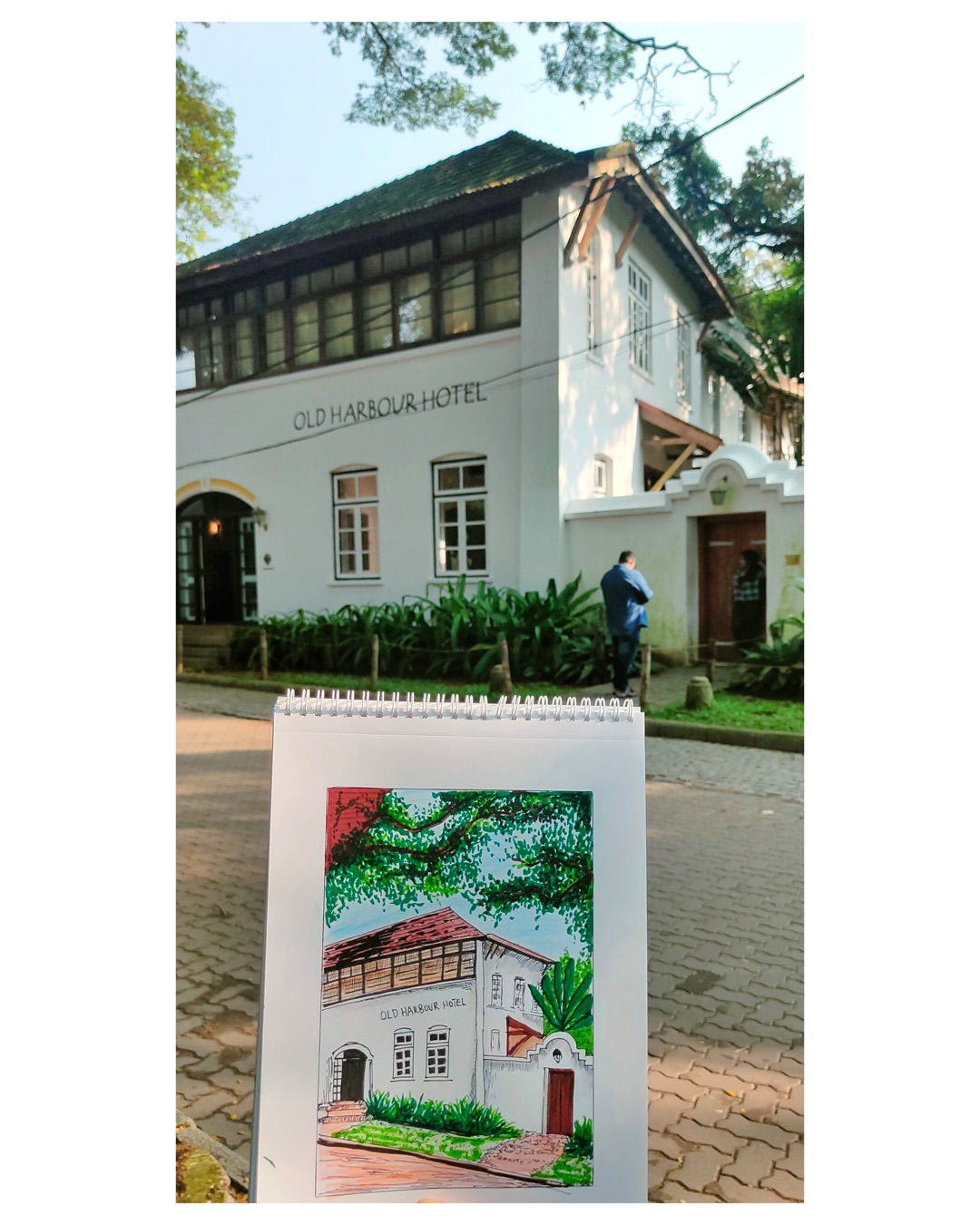
Sudhish, a user experience designer based in Kochi, Kerala, India.
As an artist, I’ve always found that certain places resonate deeply, becoming more than just a backdrop for creative exploration. Fort Kochi is one such place—a vibrant tapestry of history, culture, and natural beauty that beckons with every corner turned. In this personal account, I invite you to journey with me as I sketch the chapters of Fort Kochi, capturing its essence through my eyes and pencils.
The Arrival
Stepping off the ferry and into Fort Kochi is like stepping back in time. The salty breeze, the distant calls of fishermen, and the colourful facades of colonial buildings immediately envelop you. I made my way to my favourite spot, Teapot café overlooking the Chinese fishing nets. As I sipped my coffee, I pulled out my sketchbook, ready to capture my first impression.

Teapot Café
The Teapot Café in Fort Kochi is more than just a café; it’s an experience. Whether you’re a tea enthusiast, an artist seeking inspiration, or simply someone looking for a cozy spot to unwind, the Teapot Café offers a unique blend of charm, creativity, and hospitality. It’s a perfect example of how Fort Kochi seamlessly blends history, culture, and contemporary life, creating a place that feels both timeless and refreshingly modern.

Chinese Fishing Nets: Icons of Tradition and Innovation
The Chinese fishing nets are iconic to Fort Kochi. Their massive wooden structures against the backdrop of the Arabian Sea create a scene that is both timeless and dynamic. I started with quick, gestural lines to capture the nets’ form and movement. The fishermen, with their rhythmic pulling and lowering of the nets, added life to the sketch. I focused on the interplay of light and shadow, using cross-hatching to bring depth and dimension.

Capturing the Rust and Decay: Steam Boilers
The steam boilers on display at Fort Cochin beach were from the cranes used in the Cochin dry dock for twenty years starting from 1956. Notable use of these cranes included attending to the annual repairs of dredgers Lord Willingdon and Lady Willingdon. The boilers used coke, cool and fire wood as fuel.
Today, these steam boilers serve as a unique attraction for visitors. Their weathered surfaces, marked by rust and the effects of time, create a stark contrast against the natural beauty of the beach. For history enthusiasts and artists alike, the boilers offer a tangible connection to Fort Kochi’s maritime past, sparking curiosity and inspiring countless sketches and photographs.

Wandering Through History: Bastian Bungalow
Located near Vasco Da Gama Square, the Bastian Bungalow is now a museum that houses artefacts, paintings, and infographics about the history of Cochin. The museum is constructed in a very Indo-European style with heavy Kerala and Dutch influence — large rooms and high ceilings. The museum is located on the top floor. Several rooms explain the history of Muziris to the Kingdom of Kochi and to the Portuguese, Dutch, and finally British influences in Kochi.

Old Harbour Hotel: A Heritage Haven
At the heart of ancient Fort Cochin, Kerala, a place that exudes history and culture, is the Old Harbour Hotel. A 300 year-old building that has for long been a heritage monument of this town, now reopened as a boutique hotel. Built in the Dutch style of architecture with hints of Portuguese influences, it was the first hotel of old Cochin. Later it remained a residential home to employees of English tea-broking firms until it was left unused for a period of time.

The Rain Trees of Fort Kochi: Nature’s Umbrellas
The presence of Rain Trees in Fort Kochi is tied to the town’s colonial past. These trees were likely planted during the British colonial period, valued for their rapid growth and extensive shade. Over the years, they have become an integral part of the town’s landscape, blending seamlessly with the historic buildings and cobbled streets.

Vasco House: A Glimpse into Colonial History
Vasco House in Kochi, also known as Vasco da Gama’s House, is one of the oldest Portuguese residences in India. Located in the historic Fort Kochi area, this colonial-era building offers a fascinating glimpse into the region’s rich history and architectural heritage.
Reflection
Every sketch I created in Fort Kochi is a chapter in my artistic journey. Each scene, from the iconic fishing nets to the bustling spice market, offered a unique challenge and a chance to explore different techniques and styles. More than that, each sketch is a memory, a personal connection to this enchanting place.
Fort Kochi is a place where history and modernity blend seamlessly, where every corner has a story to tell. Through my sketches, I’ve tried to capture not just the visual beauty but also the soul of this incredible town. As an artist, Fort Kochi has given me a wealth of inspiration, and I hope that through my sketches, I can share a glimpse of its magic with you.
Teilen Sie
Recent Posts
The Nostalgic Pearl’s Hill Upper Barracks
My piece is from our February sketchwalk at Pearl’s Hill Upper Barracks....
Mehr lesenThe Flavel House Heritage Museum, Astoria
I am an architect by profession, an artist and a musician by...
Mehr lesenOld Welsh Tree
Hi, I’m Dan a 42-year old self taught artist and Urban Sketcher...
Mehr lesenThe Japanese Weddings
Attending a wedding in the most traditional city in Japan, Kyoto, is...
Mehr lesen